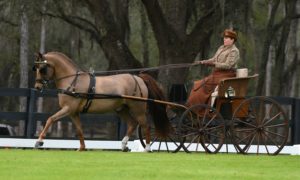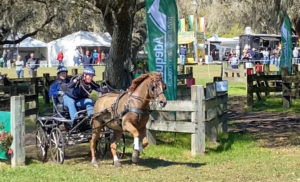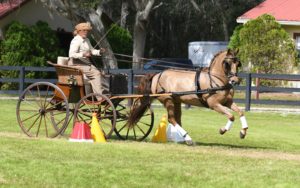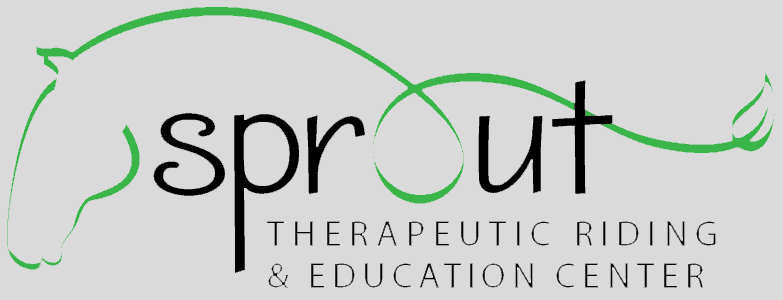
Driving Toward Your Goals!
By Anna Koopman
In the equestrian sport of Combined Driving, there are three phases of competition.
 The driven Dressage test is a series of movements and ring figures in which the driver and horse must complete at specific places in the ring. The Marathon, second phase is all about speed, endurance, flexibility and teamwork. The third phase, Cones is the precision test of the entire event. Combined Driving is a team event, even though there is one driver per entry, there is a team of people supporting that driver behind the scenes.
The driven Dressage test is a series of movements and ring figures in which the driver and horse must complete at specific places in the ring. The Marathon, second phase is all about speed, endurance, flexibility and teamwork. The third phase, Cones is the precision test of the entire event. Combined Driving is a team event, even though there is one driver per entry, there is a team of people supporting that driver behind the scenes.
Driven Dressage challenges the communication, harmony and suppleness of the horse and driver. The tests are different for each level of training of the horse and driver combined. Drivers that are new to Combined Driving begin at the Training Level then progress to Preliminary, Intermediate and Advanced. As one challenges themselves to get better, the dressage tests assist in giving the driver a framework for the training of their horse with directive remarks as a guideline to go by. The dressage phase is normally completed in a presentation vehicle with appropriate attire for the turnout.
Marathon is a whole other ballgame. Your horse must be fit enough to go the distance of about 12 kilometers, game to run in six to eight hazards and you must remember where you are going when trying to drive your horse as fast as you possibly can safely. Marathon is normally broken into 3 sections that are all timed.  The first is a trot phase of approximately 6 kilometers. One has a two-minute window in which your team must come in or incur penalty points for arriving too early or too late. The next section is a walk or transfer phase of about one kilometer which has no minimum time, just a time allowed. The third with a distance between six to eight kilometers is the hazard section. For every kilometer there is a hazard in which the driver must negotiate their horse through lettered gates lettered A thru F dependent on their division. Training level historically has completed gates A thru C, Preliminary A thru D, Intermediate A thru E and Advanced A thru F. This is a timed event. For every second spent in a hazard your team incurs 0.25 penalty points. You can (and should) study hazards as many times as possible on the days leading up to marathon looking for a different route, watching others walk and talking to other competitors about the routes that they are taking and why. When it is your time to go you need to be ready both mentally and physically for the demands of the sport. Once you and your team have successfully completed the marathon course, a team of veterinarians check out your horse’s vital signs (heart rate, respiration and temperature) and to see if your horse has not injured himself while competing.
The first is a trot phase of approximately 6 kilometers. One has a two-minute window in which your team must come in or incur penalty points for arriving too early or too late. The next section is a walk or transfer phase of about one kilometer which has no minimum time, just a time allowed. The third with a distance between six to eight kilometers is the hazard section. For every kilometer there is a hazard in which the driver must negotiate their horse through lettered gates lettered A thru F dependent on their division. Training level historically has completed gates A thru C, Preliminary A thru D, Intermediate A thru E and Advanced A thru F. This is a timed event. For every second spent in a hazard your team incurs 0.25 penalty points. You can (and should) study hazards as many times as possible on the days leading up to marathon looking for a different route, watching others walk and talking to other competitors about the routes that they are taking and why. When it is your time to go you need to be ready both mentally and physically for the demands of the sport. Once you and your team have successfully completed the marathon course, a team of veterinarians check out your horse’s vital signs (heart rate, respiration and temperature) and to see if your horse has not injured himself while competing.
Cones is on the third day of competition and is comprised of about twenty sets of cones with balls on the top of them. For every ball that is knocked off, three penalty points will be added to your score.  There is a certain width for each division in which the cones are set based on the with of your carriage wheels. As one moves up the levels in competition the cones are set closer together and the time in which you must complete the course speeds up. The advanced width gives you about two inches on either side of your wheels. One must drive with precision, concentration and connection. Double clean in cones means that you did not knock down any balls and you made the time allowed. The third phase must be completed in the same carriage as the dressage test.
There is a certain width for each division in which the cones are set based on the with of your carriage wheels. As one moves up the levels in competition the cones are set closer together and the time in which you must complete the course speeds up. The advanced width gives you about two inches on either side of your wheels. One must drive with precision, concentration and connection. Double clean in cones means that you did not knock down any balls and you made the time allowed. The third phase must be completed in the same carriage as the dressage test.
Now, how might you say does Combined Driving relate to life?
Our Motivation Monday interviewee, Diane Kastama, found combined driving out of a love for horses, a need to go fast and a desire to push her limits. She has competed up to the top of the sport against able bodied drivers and at the Para Championships winning a GOLD medal. She pushes herself to get up in the morning, care for her horses herself, condition her own horses and compete when she can. She strives to be excellent at dressage, but her most recent goal was to find a great marathon horse! Diane at the last world championships leased a horse from Koos de Ronde, a top world ranked four-in-hand driver. She had the opportunity to drive one of his amazing marathon horses. Diane was able to feel what it felt like to chase her dreams of going fast. She wanted to find a horse of her own that could give her that thrill of going fast, the torque of the acceleration and the reflexes to turn on a dime.
I can totally relate to Diane. My current competition pony, Navu had excelled at the dressage phase; marathon and cones were a struggle. We spent last summer at Sprout going slow back to the basics, working on “dressage in hazards” and trotting cones courses with every drive. We were able to build on this base during the winter season and slowly we started getting faster in the hazards. We had one double clean cones in competition at Nature Coast and our best marathon phase of the season at the Live Oak International at the beginning of March!
Navu had the fastest time in the Adequan hazard out of all of the FEI competitors! AND the work we put in behind the scenes along the way allowed us to feel good about moving up a division from Intermediate to Advanced…
We have a new and exciting goal, but with that, lots of homework to do!
With the current “stay at home” COVID-19 protocols, we have all been given a bit more time to think about what matters to us.
So, what matters to you? What are your goals? What will it take for you to achieve them? Use this time to study your course, plan your actions and be ready to drive forward towards the future!
